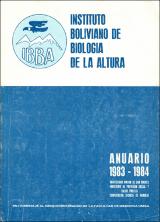Mostrar el registro sencillo del ítem
Hemodynamic study of acute high altitude pulmonary edema (Hape)
| dc.contributor.author | Antezana, G | |
| dc.contributor.author | Leguía, G | |
| dc.contributor.author | Morales Guzmán, A | |
| dc.contributor.author | Coudert, J | |
| dc.contributor.author | Spielvogel, H | |
| dc.date.accessioned | 2022-02-16T19:24:49Z | |
| dc.date.available | 2022-02-16T19:24:49Z | |
| dc.date.issued | 1982 | |
| dc.identifier.uri | http://repositorio.umsa.bo/xmlui/handle/123456789/27085 | |
| dc.description.abstract | SUMMARY High Altitude Pulmonary Edema (HAPE) occurs frequently in the Andean population. Occasionally it can be extremely severe and cause death. The transportation system between the Bolivian lowland and the Andean regions (above 3600 m) has improved considerably during the last few years and traveling to high altitude takes only a few hours nowadays. The dry climate as well as other factors like smoking, respiratory infections, unusually strenuous effort, trigger HAPE. Exceptionally severe HAPE occurs more frequently in high altitude natives on return from the lowlands than in newcomers to high altitude. Initially they develop a kind of acute mountain sickness or "sorojche" with headaches, shortness of breath and vomiting which are followed by the typical respiratory syndrome of dyspnea, cough, foamy expectoration and hemoptysis of varying severity. We have studied patients 1) during the acute phase, 2) during recovery, and 3) a group of patients with a history of previous HAPE as follow up study. In the first group the study was carried out during the first 24 hours. The patients had a mean age of 22.4 years. We found marked hyperventilation, hypoxemia expressed by a drop of Pa02 to 35.0 mm Hg and arterial desaturation (Sa02 = 72.5%), a decrease of alveolar oxygen tension and an increase of the alveolar-arterial oxygen gradient (P A-a) 02). None of the patients had polycythemia or anemia. The cardiac index was low and pulmonary artery pressure (Pap) unusually high with normal or low pulmonary wedge pressure. Breathing of 100% oxygen caused a fall of pulmonary artery pressure to normal levels only in two cases (mean Pap 21 mm Hg). In the second group (recovery) one patient had an elevated pulmonary artery pressure still after 10 days and presented a slow clinical evolution. After 3 months the same patients Pap was normal at rest but extremely high during exercise. The Third group showed an increase of Pap even during minimun exercise. HAPE is a syndrome of loss of adaptation to high altitude. It is supposed that muscular pulmonary arteries and muscularised arterioli of the high altitude natives in a hyperoxic environment (lowlands or sea level) regress unevenly. On return to the hypoxic environment, arterial vasoconstriction affects the vasculature which did not regress. Vasoconstriction causes pulmonary hypertension with changes in regional perfusion, a process that is very dangerous for the zones of vasculature that has regressed and is therefore… | es_ES |
| dc.language.iso | en | es_ES |
| dc.publisher | Instituto Boliviano de Biología de la Altura | es_ES |
| dc.subject | EDEMA PULMONAR | es_ES |
| dc.subject | ALTURA | es_ES |
| dc.subject | HAPE | es_ES |
| dc.title | Hemodynamic study of acute high altitude pulmonary edema (Hape) | es_ES |
| dc.type | Article | es_ES |

